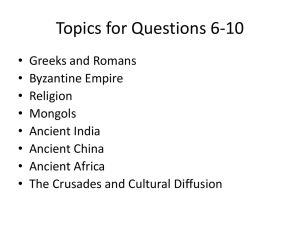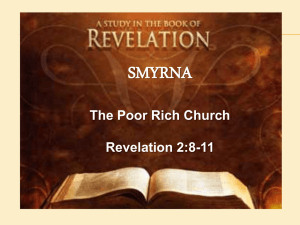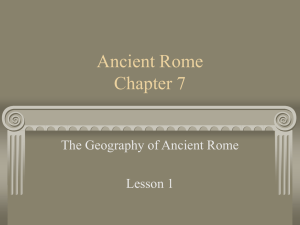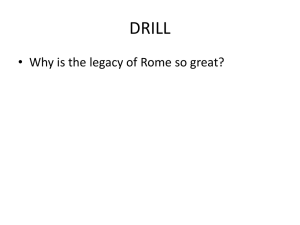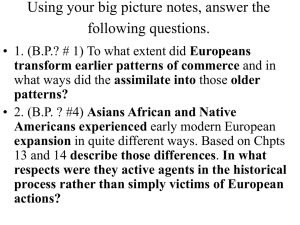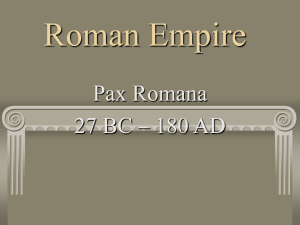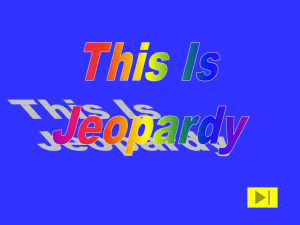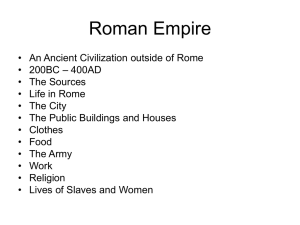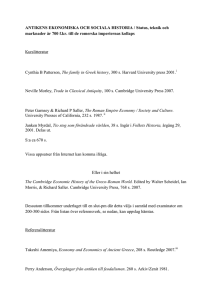Chapter 11 - Burnet Middle School
advertisement
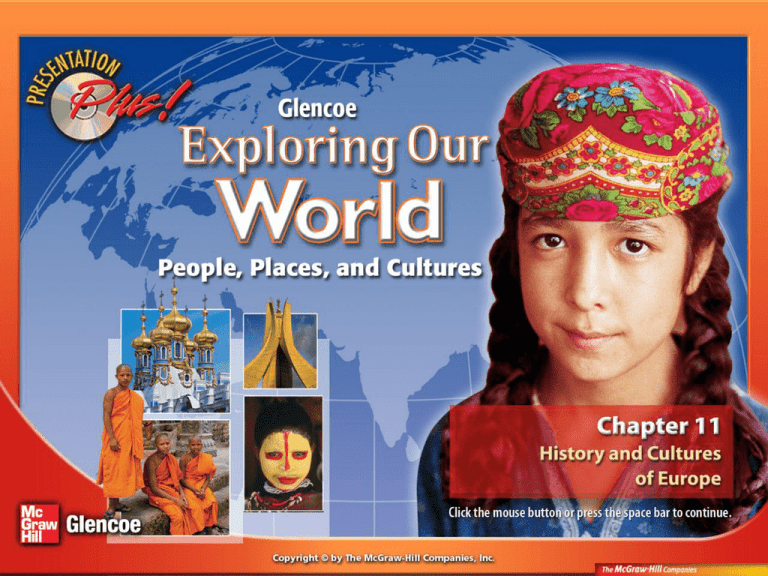
Chapter Introduction Section 1: History and Governments Section 2: Cultures and Lifestyles Visual Summary Regions Europe is rich in history and culture. Like the United States, most countries in Europe are industrialized and have high standards of living. Unlike the United States, however, the people of Europe do not share a common language and government. What forces have helped unify Europeans at different times? Section 1: History and Governments The characteristics and movement of people impact physical and human systems. Over the centuries, migrations and wars have brought different groups to power in Europe. As modern nations have taken the place of empires and kingdoms, ways of living and thinking have also changed. Section 2: Cultures and Lifestyles Culture groups shape human systems. Europe is a region of many peoples with different ethnic backgrounds, languages, religions, and traditions. Despite their differences, Europeans lead similar lifestyles and share a rich cultural heritage. The characteristics and movement of people impact physical and human systems. Content Vocabulary • classical • feudalism • city-state • nation-state • democracy • revolution • republic • Holocaust • emperor • communism • pope Academic Vocabulary • dominant • authority • currency Who is that giant? Is it a warrior? A farmer? A king? One thing is certain—at almost 230 feet (70 m) high, the Long Man of Wilmington, in England, is one of the world’s largest carved figures. Originally a chalk outline that became overgrown by grass, the Long Man was restored in 1969 with 770 concrete blocks. As scientists study the earth around the giant, they will be better able to judge when it was made—and maybe even why it was made! Read this section to learn more about the history of Europe. Do you think technology can have a negative impact upon society? A. Yes B. No A. A B. B 0% A 0% B Legend has it that when Gordius, a mythological Grecian king, tied a knot that was impossible to untie, a wise priestess revealed that the person who could loosen it would command a huge kingdom. Alexander the Great discovered that there were no ends in the knot. Since he could not untie it, he cut it in half with his sword. He later became ruler of an enormous empire. Since that time, difficult problems are often referred to as Gordian knots. Ancient Europe Ancient Greece and Rome laid the foundations of European civilization. Ancient Europe (cont.) • The story of European civilization begins with the ancient Greeks and Romans, now known as the classical world. • These peoples settled near the Mediterranean Sea more than 2,500 years ago. Ancient Europe (cont.) • The earliest Greek civilizations began among farming and fishing peoples who lived near the Aegean Sea. – They grew wealthy through trade. Ancient Europe (cont.) • Warfare led to these civilizations’ decline, but independent territories called city-states developed throughout Greece. Ancient Europe (cont.) • The city-state of Athens became one of the most powerful city-states in Greece. – Athens introduced the world’s first democracy, a political system in which all citizens share in running the government. – Learning and the arts also thrived in Athens. – Among the city-state’s great thinkers were Socrates, Plato, and Aristotle. Ancient Europe (cont.) • During the mid-300’s B.C., Phillip II of Macedonia conquered Greece. • Philip’s son Alexander the Great eventually ruled Egypt, Persia, and part of India. Ancient Europe (cont.) • Alexander died young, however, and his empire quickly broke into smaller kingdoms. • By about 130 B.C., the Romans had conquered most of the Greek kingdoms. Ancient Europe (cont.) • While Greece ruled the eastern Mediterranean, Rome became a dominant power on the Italian Peninsula. • Rome began as a monarchy but changed to a republic in 509 B.C. • In a republic, people choose their leaders. Ancient Greek and Roman Empires Ancient Europe (cont.) • One of the Roman government’s achievements was the development of a code of laws. • Written on bronze tablets known as the Twelve Tables, the laws held that all free citizens had the right to be treated equally. Ancient Europe (cont.) • When Rome seized new territories, it allowed many of the conquered people to become Roman citizens. • Citizenship created a strong state with loyal members. Ancient Europe (cont.) • The first emperor, or all-powerful ruler, was Augustus, who gained that position in 27 B.C. • His rule began a time of peace, artistic growth, and expanding trade that lasted for 200 years—a period called the Pax Romana. Ancient Europe (cont.) • During the Pax Romana, Christianity was developing in Palestine in the eastern part of the Roman Empire. • Jesus of Nazareth preached a message of love and forgiveness. • His enemies had Jesus executed, but his followers reported that Jesus rose from the dead. Ancient Europe (cont.) • Two early Christian leaders, Peter and Paul, established the Christian Church in Rome. • Despite abuses against it, the new religion grew in popularity, and in A.D. 392, Christianity became Rome’s official religion. Ancient Europe (cont.) • By the late A.D. 300s, the Roman Empire was in decline and under attack. • About A.D. 395, the empire was divided into eastern and western parts, and in A.D. 476, it came to an end. Despite its fall, how did the Roman Empire influence Europe and the West? A. Helped spread classical culture and Christianity 0% D A B C0% D C D. None of the above 0% A C. Both A and B A. B. C. 0% D. B B. Helped shape the legal systems in many countries Expansion of Europe During the Middle Ages, European society, religion, and government underwent great changes. Expansion of Europe (cont.) • After Rome’s fall, Europe entered the Middle Ages, a 1,000-year period between ancient and modern times. • During the Middle Ages, Christianity formed into two separate branches. • The Roman Catholic Church, based in Rome, was headed by a powerful pope. • The Eastern Orthodox Church was centered in the Byzantine Empire. Expansion of Europe (cont.) • About A.D. 800, a Germanic king named Charlemagne united much of western Europe. • After his death, a new political and social system arose, called feudalism. • Under this system, kings gave land to nobles. • In turn, nobles provided military service, becoming knights, or warriors, for the king. Expansion of Europe (cont.) • Most western Europeans were poor peasants who worked hard and had limited freedom. Expansion of Europe (cont.) • In feudal times, the Christian faith united Europeans. • The religion of Islam, founded in the A.D. 600s by an Arab named Muhammad, was on the rise. • Followers of Islam, called Muslims, spread and gained control of Palestine, alarming Christians who considered this the Holy Land. Expansion of Europe (cont.) • Beginning in the 1000s, nobles from western Europe gathered volunteers into large armies to win back the Holy Land. – These religious wars were called the Crusades. Expansion of Europe (cont.) • The Crusades had a major impact on Europeans. Goods began to flow more steadily between Europe and the Muslim lands. • Kings taxed the trade and took over land from nobles who left to fight in the Crusades. • As a result, feudalism gradually withered, and Europe’s kingdoms grew stronger and larger. Expansion of Europe (cont.) • Many of them later became modern Europe’s nation-states. • A nation-state is a country made up of people who share a common culture or history. Expansion of Europe (cont.) • In the 1300s, people all across Europe battled the bubonic plague, or Black Death. – This disease killed about a third of Europe’s population, causing a shortage of labor. – Workers, now in demand, earned higher wages and gained more freedom. Expansion of Europe (cont.) • Muslim-Christian conflict arose again in Spain in the late 1400s. • In what came to be known as the Reconquest, Spanish rulers forced out the Muslims and united the country in 1492. Expansion of Europe (cont.) • Between about 1350 and 1550, new interest in art and learning resulted in a period called the Renaissance, or “rebirth.” • Poets, sculptors, and painters, such as Michelangelo and Leonardo da Vinci, created stunning masterpieces. • During the 1500s, humanism led people to think that reason was just as important as faith in the path to knowledge. Expansion of Europe (cont.) • In 1517 Martin Luther, a German religious leader, set out to reform, or correct, certain Roman Catholic practices. – Luther’s ideas sparked a religious movement called the Reformation, which led to a new form of Christianity called Protestantism. Expansion of Europe (cont.) • Wars between Roman Catholics and Protestants soon swept through Europe. • As the authority of church leaders was challenged, kings and queens claimed more authority for themselves. Expansion of Europe (cont.) • As Europe’s kingdoms grew stronger, European seafarers began a series of ocean voyages that led to a great age of exploration. • Sailing for Spain in 1492, Christopher Columbus tried to find a different route to Asia. • His voyage took him to the Americas, continents unknown in Europe at the time. Expansion of Europe (cont.) • Other countries sent out their own explorers and founded colonies, or overseas settlements, in the Americas, Asia, and Africa. • Trade with the colonies brought Europe great wealth and power but often destroyed the local cultures in the process. History at a Glance What important new idea came from the Renaissance period? A. Humanism B. Feudalism B A A. A B. B 0% C.0%C 0% C C. the Crusades Modern Europe From the 1600s to the 1800s and beyond, new ideas and discoveries helped Europe become a global power. Modern Europe (cont.) • After the Renaissance, educated Europeans turned to science as a way to find truth. • New ideas, such as those of Copernicus and Galileo, sparked a revolution, or sweeping change, in the way people thought about life and nature. Modern Europe (cont.) • This Scientific Revolution led people to believe that reason could bring both truth and error to light. – As a result, the 1700s became known as the Age of Enlightenment. Modern Europe (cont.) • Inspired by the American war for independence in 1775, the people of France carried out their own political revolution in 1789. – Soon thereafter, Napoleon Bonaparte gained power and made himself emperor. – He was defeated in 1815. History at a Glance Modern Europe (cont.) • Meanwhile, the Industrial Revolution was beginning in Britain. – Instead of making goods by hand, people began using machines and building factories. – Machines could produce goods faster and at lower cost, so people could now afford more things. Modern Europe (cont.) • Industrial advances helped European countries grow more powerful. • They developed many new weapons and competed aggressively for colonies. • Tensions soon led to World War I (1914–1918) and World War II (1939–1945). • A major horror of World War II was the Holocaust, the mass killing of 6 million European Jews by Germany’s Nazi rulers. Modern Europe (cont.) • After World War II, the United States and the Communist Soviet Union became rivals in a struggle for world power known as the Cold War. • Communism is a system in which government controls the ways of producing goods. Modern Europe (cont.) • In 1989 people in Eastern Europe forced several Communist governments from power and set up new democracies. – A year later, East and West Germany merged to become one democratic state. – Then in 1991, the Soviet Union broke apart. Modern Europe (cont.) • In 1993 several democracies in western Europe formed the European Union (EU). – Several eastern European countries joined later. – The goal of the EU is to unite Europe. The European Union Modern Europe (cont.) • The European Union allows goods, services, and workers to move freely among member countries. • It has also created a common EU currency called the euro. • Member countries can now trade more easily among themselves because there is no need to exchange currencies. The European Union Who was an important Enlightenment thinker? A. Nicolaus Copernicus B. John Locke C. Galileo Galilei D. Napoleon 0% A A. B. C. 0% D. B A B C 0% D C 0% D Culture groups shape human systems. Content Vocabulary • ethnic group • urbanization • welfare state • secular • fertility rate Academic Vocabulary • bond • attitude Bog snorkeling? For more than twenty years, competitors wearing snorkels and flippers have met in the small town of Powys, Wales, to swim in its slimy bog. The challenge is to swim the fastest without using any standard swimming strokes. The justfor-fun event has attracted swimmers from as far away as South Africa and Australia. Read Section 2 to learn more about the cultures and lifestyles of Europeans. Should students be required to speak the same language? A. Yes B. No A. A B. B 0% A 0% B As evidence of the third-lowest fertility rate in Europe, the average Italian family now has just one or two children. Women give several reasons for their smaller households. Higher education has opened career doors for women, causing some to postpone starting families until later in life. Childcare is unaffordable for most. The Italian workplace offers few part-time jobs. And some women say that until their husbands start helping around the home, one child is enough. Population Patterns Ethnic differences and population changes pose challenges for Europe. Population Patterns (cont.) • Today Europe is home to many ethnic groups. – An ethnic group is a group of people with shared ancestry, language, and customs. Population Patterns (cont.) • Having a common heritage or culture creates bonds among people. • National ethnic loyalties have also led to conflict, such as that in Yugoslavia in the 1990s. Population Patterns (cont.) • Despite some divisions, Europeans have a growing sense of unity. – Shared values go beyond ethnic or national loyalties. – For example, Europeans value democracy and human rights and believe governments must care for their citizens. Population Patterns (cont.) • Many European countries are welfare states in which the government is the main provider of support for the sick, the needy, and the retired. Population Patterns (cont.) • Because of recent immigration of people from Asia, Africa, and Latin America, Europe’s population is undergoing change. • Although the number of immigrants is increasing, the region’s overall population is decreasing due to a low fertility rate, or the average number of children born to each woman. • Europe is expected to have 10 percent fewer people by 2050. An ethnic group is a group of people with shared ancestry, language, and customs. A. True B. False A. A B. B 0% B A 0% Life in Europe European lifestyles today reflect the region’s urban society and level of wealth. Life in Europe (cont.) • The Industrial Revolution changed Europe from a rural, farming society to an urban, industrial society. – The concentration of people in towns and cities is known as urbanization. – Today, three of every four Europeans live in cities. Life in Europe (cont.) • Europe boasts one of the world’s most advanced transportation networks, which includes railway, highway, river and canal, and airline systems. – Most transportation systems are government owned. Life in Europe (cont.) • Europeans tend to be well educated, with more than three-fourths of young people completing high school. • Because of their high levels of education, Europeans earn more money than people in many other parts of the world. Life in Europe (cont.) • In many European countries, workers receive four weeks of paid vacation each year. In which country do workers receive four weeks of paid vacation? A. Germany B. Italy C. France D. Europe 0% A A. A B. B C. 0%C 0% D. D B C 0% D Religion and the Arts Religion, especially Christianity, has had an important effect on European society and arts. Religion and the Arts (cont.) • For centuries, Christianity was a major influence in European life. • Since the 1700s, however, European attitudes have become more secular, or nonreligious. Religion and the Arts (cont.) • Judaism and Islam also have influenced European culture. • Today, Jewish communities thrive in all major European cities, and Muslim immigrants are pouring into the region by the thousands. Religion and the Arts (cont.) • For the most part, Europeans of different faiths live together peacefully. • In some cases, though, religious differences have led to violence. Europe’s Religions Religion and the Arts (cont.) • Examples are the Catholic–Protestant hostilities in Northern Ireland and the troubles among Roman Catholic, Eastern Orthodox, and Muslim groups on the Balkan Peninsula in the 1990s. Europe’s Religions Religion and the Arts (cont.) • The arts have flourished in Europe for centuries. What is the most popular religion in Europe? A. Roman Catholicism B. Eastern Orthodox 0% D A 0% C D. Islam A. A B. B C. 0%C 0% D. D B C. Protestantism Ancient Europe • The Greek city-state of Athens introduced the world’s first democracy. • Rome influenced later civilizations through its legal system, its language, and its role in the spread of Christianity. • Invasions by Germanic peoples led to the Roman Empire’s decline. Europe’s Expansion • Christianity shaped Europe’s society and culture during the Middle Ages. • The Renaissance, which began in Italy, brought about a new interest in learning. • European countries controlled various parts of the world as a result of explorations overseas. Modern Europe • Through revolutions people challenged the power of kings and demanded certain rights for citizens. • As industries grew, many people left rural areas to find work in city factories. • Two costly world wars led European countries to seek peace and greater unity. Population Patterns • Europe is densely populated in many areas. • Europe’s population is aging, and the total population is declining. • Many people have immigrated to Europe from Asia, Africa, and Latin America. Life and Culture • Europeans tend to live in urban areas and have relatively high levels of education and income. • With more leisure time, Europeans enjoy sports such as soccer. • European society and culture have become more secular. The Industrial Revolution increased the availability of goods through the use of machinery and faster transportation to market. classical referring to the civilizations of ancient Greece and Rome city-state independent political unit that includes a city and the surrounding area democracy form of limited government in which power rests with the people, and all citizens share in running the government republic government in which people choose their leaders emperor all-powerful ruler pope head of the Roman Catholic Church feudalism political and social system in which kings gave land to nobles in exchange for the nobles’ promise to serve them; those nobles provided military service as knights for the king nation-state country formed of people who share a common culture and history revolution one complete circuit around the sun; sweeping change Holocaust mass killing of 6 million European Jews by Germany’s Nazi leaders during World War II communism system of government in which the government controls the ways of producing goods dominant having controlling influence over others authority power or influence over others currency money ethnic group people with a common language, history, religion, and some physical traits welfare state country where the government is the main provider of support for the sick, needy, and the retired fertility rate average number of children born to each woman urbanization growth of cities secular nonreligious bonds a uniting or binding force or influence attitudes a particular feeling or way of thinking about something To use this Presentation Plus! product: Click the Forward button to go to the next slide. Click the Previous button to return to the previous slide. Click the Home button to return to the Chapter Menu. Click the Transparency button from the Chapter Menu, Chapter Introduction, or Visual Summary slides to access the transparencies that are relevant to this chapter. From within a section, click on this button to access the relevant Daily Focus Skills Transparency. Click the Return button in a feature to return to the main presentation. Click the Geography Online button to access online textbook features. Click the Reference Atlas button to access the Interactive Reference Atlas. Click the Exit button or press the Escape key [Esc] to end the chapter slide show. Click the Help button to access this screen. Links to Presentation Plus! features such as Graphs in Motion, Charts in Motion, and figures from your textbook are located at the bottom of relevant screens. This slide is intentionally blank.
